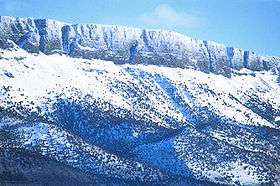Abert Rim
| Abert Rim | |
|---|---|
 Abert Rim in the winter | |
| Highest point | |
| Elevation | 7,548 ft (2,301 m) [1] |
| Prominence | 2,500 ft (760 m) |
| Coordinates | 42°23′18″N 120°14′05″W / 42.38825°N 120.23476°WCoordinates: 42°23′18″N 120°14′05″W / 42.38825°N 120.23476°W |
| Geography | |
 Abert Rim Oregon | |
| Location | Lake County, Oregon, US |
| Geology | |
| Mountain type | Fault-block escarpment |
Abert Rim in Lake County, Oregon is one of the highest fault scarps in the United States. It rises 2,490 feet (760 m) above the valley floor, finishing with a 820-foot (250 m) sheer-sided basalt cap. It was formed during the Miocene epoch. At that time basaltic flood lavas covered much of eastern Oregon. In subsequent faulting, great blocks were tilted and Abert Rim is at the western end of one of these blocks, while Lake Abert lies on top of another. Stretching more than 30 miles (48 km) from Lakeview north to Alkali Lake, Abert Rim is also the longest exposed fault scarp in North America.
Bighorn sheep were transplanted to the rim in 1975 and 1977 from nearby Hart Mountain, and are often spotted from the Abert Rim geologic point of interest sign located along Highway 395. Raptors, such as the Ferruginous Hawk, are also common in the area.
The Chewaucan River enters the lake from the south, however it has no outlet. The lake level varies depending on rainfall and it nearly completely dried up 140 years ago. It is one of the Great Basin lakes.
The escarpment and lake were first mapped on December 20, 1843, by John C. Frémont, who named it after Colonel John James Abert, his commanding officer.[2]
The southern section of Abert Rim is a popular spot for hang gliding because of the frequent thermals created by warm valley air rising up against the cliffs. The area is considered by many to be the hang gliding capital of the West. National hang gliding festivals are held each year in late June and during the Fourth of July.
See also
References
- ↑ "Abert Rim". SummitPost.org. Retrieved 26 February 2010.
- ↑ Gannett, Henry (1905). The Origin of Certain Place Names in the United States. p. 22.
External links
- Bishop, Ellen. "Abert Rim". The Oregon Encyclopedia.
 Media related to Abert Rim at Wikimedia Commons
Media related to Abert Rim at Wikimedia Commons
